Every day, I see stories about some person contacting the media to complain Apple wouldn’t reimburse them for in-app purchases their kids made on an iPad. You see people complaining about charges of a couple hundred dollars to well over $1000 made in a 10 minute period. The latest story I’ve been seeing is about a British policeman who actually reported his own 13-year old son for fraud for running up a £3,700 (about $5614) bill on his iPad. See The Inquisitr‘s website for the full story. In the story, Doug Crossan claims his son didn’t understand he was making purchases, and he thinks Apple should forgive this huge bill. Since Apple refused, Crossan reported his kid for fraud, not because he wants to get his child in legal hot water, but because he wants to “embarrass Apple as much as possible”, as quoted by The Inquisitr.
Apple has forgiven charges in the past, but those were mostly made in a short time frame by very young kids who probably didn’t understand they were giving Apple their parents’ real money in exchange for some game coins or pretend food to feed the pretend animals. I think a 13-year old kid certainly has some concept of money, how to use it to purchase things, and how hard his parents worked to earn that money. And apparently his charges accrued over time and from multiple games, which indicates to me that the kid often had unattended access to the iPad. I think the fault for running up this bill lies firmly with the father for not utilizing the safeguards that Apple has installed in iOS to prevent “accidentally” running up charges. Do I think Apple could make it easier to set these limits – yes. But I also think you should use some common sense before handing over an iPad to a kid. Everything you need to prevent unauthorized charges can be found in the Settings app on your iPad (or iPhone).
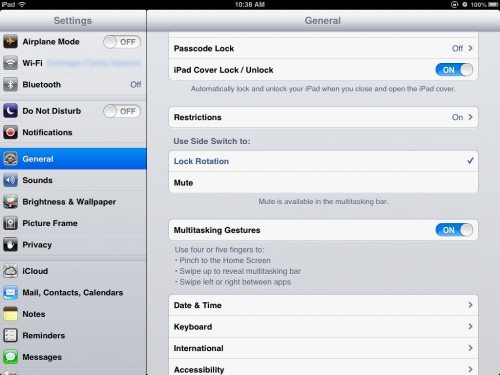
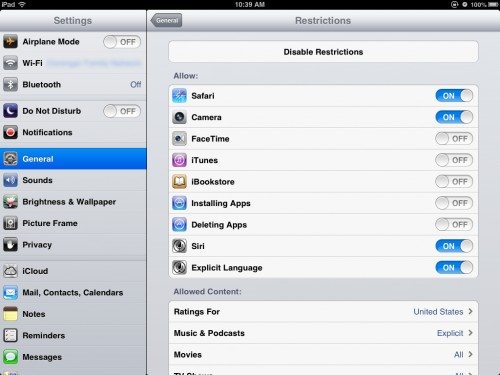 My daughter has an iPad of her own. Before I gave it to her, I enabled restrictions on it to prevent her from making purchases on her iPad. I did this because she wants to benefit from the riches of my iTunes account – thousands of songs bought over the years, hundreds of apps – all purchased by me. She doesn’t know the password required to change these restrictions, and she doesn’t know the password to the family iTunes account, either. If she had her own personal iTunes account, I wouldn’t have been so quick to put restrictions on her iPad, but I bought the iPad for her and I buy the content, so I get to control it. And my daughter is 17 years old. She’s still a minor, unable to enter into a binding legal contract with Apple, so I’m stuck holding the legal and financial reins. I expect to pay thousands (and thousands) for her college education – not for a few hours of game time.
My daughter has an iPad of her own. Before I gave it to her, I enabled restrictions on it to prevent her from making purchases on her iPad. I did this because she wants to benefit from the riches of my iTunes account – thousands of songs bought over the years, hundreds of apps – all purchased by me. She doesn’t know the password required to change these restrictions, and she doesn’t know the password to the family iTunes account, either. If she had her own personal iTunes account, I wouldn’t have been so quick to put restrictions on her iPad, but I bought the iPad for her and I buy the content, so I get to control it. And my daughter is 17 years old. She’s still a minor, unable to enter into a binding legal contract with Apple, so I’m stuck holding the legal and financial reins. I expect to pay thousands (and thousands) for her college education – not for a few hours of game time.
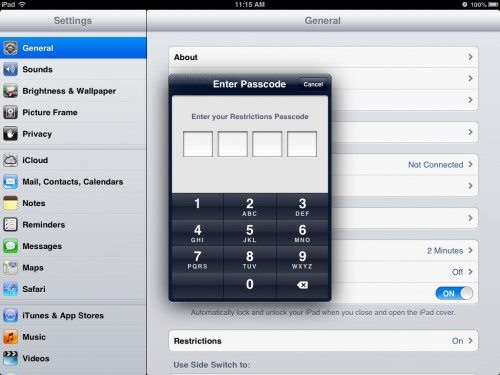 By the way, you’ll need to set a password for restrictions. You’ll create one when you first enable restrictions, and you’ll need to enter it every time you want to enter the restrictions option. Be sure you don’t use the same password for the restrictions options that you use for your iPad’s general password, because your kid or other users may know that one.
By the way, you’ll need to set a password for restrictions. You’ll create one when you first enable restrictions, and you’ll need to enter it every time you want to enter the restrictions option. Be sure you don’t use the same password for the restrictions options that you use for your iPad’s general password, because your kid or other users may know that one.
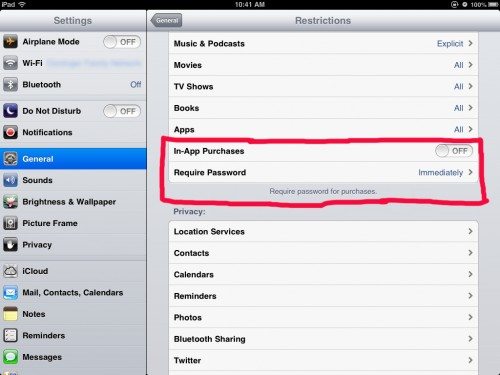 All these disputed in-app charges seem to stem from games that are free to download, but have restricted play unless you purchase add-ons from within the app itself. Years ago, after I heard the first story about some kid racking up a big bill, I remember Apple forgave those charges and implemented some restrictions that would prevent similar charges in the future. Before the first problems were reported, you had free access to the iTunes stores for fifteen minutes before you’d be asked to enter your password again. This caused problems for some parents who would download a game and then hand the iPad to a kid. The kid had fourteen minutes or so to buy as many things within a game as he could tap on before he’d need to enter a password.
All these disputed in-app charges seem to stem from games that are free to download, but have restricted play unless you purchase add-ons from within the app itself. Years ago, after I heard the first story about some kid racking up a big bill, I remember Apple forgave those charges and implemented some restrictions that would prevent similar charges in the future. Before the first problems were reported, you had free access to the iTunes stores for fifteen minutes before you’d be asked to enter your password again. This caused problems for some parents who would download a game and then hand the iPad to a kid. The kid had fourteen minutes or so to buy as many things within a game as he could tap on before he’d need to enter a password.
Now you can use the iPad’s Restrictions options in the Settings app to require a password immediately, or every time a purchase is made, in other words. Having set it to immediately may be a pain when you’re making purchases, but it can prevent your kid, or other unauthorized purchaser, from buying anything from any of the iTunes stores – apps, music, movies, etc – without knowing the password. To be extra safe, you can even prevent in-app purchases at all.
That some games have in-app purchases is easily determined. You’ll see in the lead photo a list of the popular in-app purchases and their prices for the Toon Shooters game. I found this list of prices by scrolling down in the details listing for the game. (I’m not picking on the Toon Shooters game; it was just the first free app I noticed on the Featured page in the App Store that looked like it was suitable for younger kids.)
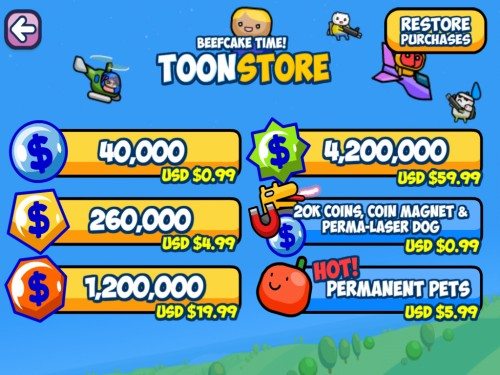 Granted, little kids may not understand the in-app purchase screen for the Toon Shooters app. He may not understand that buying some permanent pets will cost $6 real dollars, but I think a 13-year old kid would understand this.
Granted, little kids may not understand the in-app purchase screen for the Toon Shooters app. He may not understand that buying some permanent pets will cost $6 real dollars, but I think a 13-year old kid would understand this.
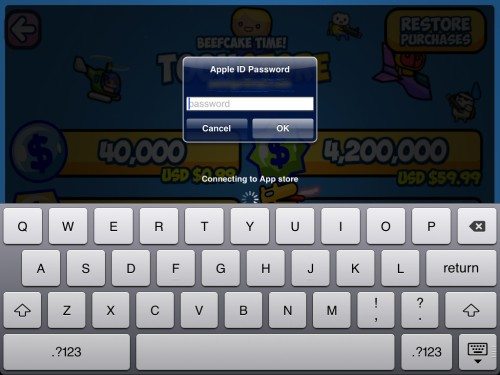 If you’ve left the restriction setting to allow 15 minutes before re-entering the password, incurring a charge is as simple as tapping one of the on-screen buttons. If you require a password for each and every purchase, the kid will be stopped by the need to enter the password – unless you’ve given him the iTunes password. If you’ve given the kid the password, you’ve in effect told him he’s free to purchase anything he wants with your money.
If you’ve left the restriction setting to allow 15 minutes before re-entering the password, incurring a charge is as simple as tapping one of the on-screen buttons. If you require a password for each and every purchase, the kid will be stopped by the need to enter the password – unless you’ve given him the iTunes password. If you’ve given the kid the password, you’ve in effect told him he’s free to purchase anything he wants with your money.
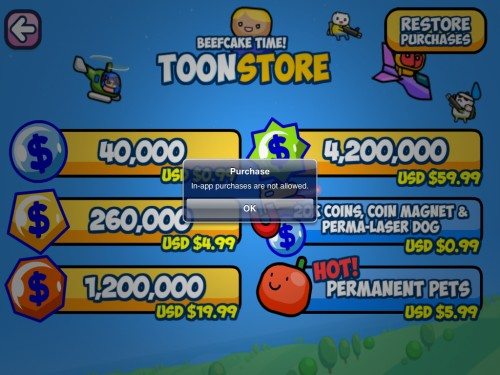 If you’ve taken the extra step to block in-app purchases, the kid can still see the screen full of goodies, but he won’t be able to purchase anything. He can tap on the buttons, but he’ll see the message shown above.
If you’ve taken the extra step to block in-app purchases, the kid can still see the screen full of goodies, but he won’t be able to purchase anything. He can tap on the buttons, but he’ll see the message shown above.
These restrictions can be a pain for parents who share their iPad with their kids. You’ll have to go into the Restrictions option in the Settings app to turn back on in-app purchases if you want to make one, but I think it’s better than finding out the hard way that your kid has been spending cash like there’s no tomorrow.
I think Apple could make it easier to control what users can and can’t do. If they see iPads as the successor to computers, they need to allow for some of the same features that computers offer families. With computers, you can create multiple accounts for multiple users. Each account can limit what the user can do. Not every person in a family owns their own computer, and not every person in a family owns their own iPad. Since families may be sharing a single device, perhaps the iPad should allow different passwords for different users, so that your kids can have an account that has only limited apps available to them and lots of restrictions on purchases made against the iTunes account. Older kids could have more access to apps and maybe even more access to the iTunes stores, while younger kids have very limited access to apps and none to the store, and the adults could have full access to everything. The adults would also be the ones who can edit the limits set on the kids’ accounts. Or perhaps something akin to the Airplane Mode setting could work. You could set Child Mode with a single swipe before handing the iPad to a kid, so the kid would have no access to the iTunes account, no access to the Settings app, and maybe even limited access to other types of apps. Maybe the Child Mode could limit access to only the apps stored in a single folder, where you could place the games and apps you allow your kid to use.
In any event, Apple has made some restrictions available to prevent your kid from racking up a huge bill on your credit card. They aren’t as fully-featured as they could be, but they are there, and the parent is responsible for the bills the kids run up if they don’t make use of these restrictions. Do you agree?

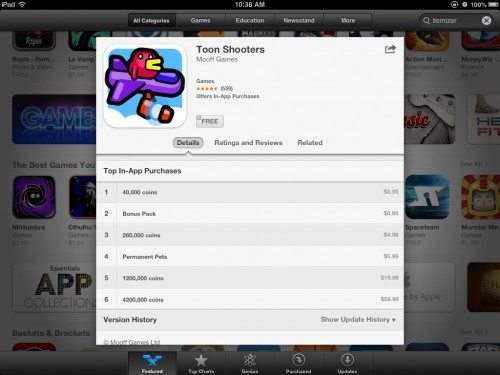


Gadgeteer Comment Policy - Please read before commenting
Btw you reminded me of how sick this new culture of in-app purchases (for games) is : instead of trying hard and mastering your technique, waiting for things to happen, failing – before you succeed, you can pay to obtain an unfair advantage over other players. That’s the exact opposite of Fair Play.
Yep, time to put in passwords and locks, if not take away the privilege of using the device in the first place.
If you are going to hand your iGadget over to a very young person, another VERY important restriction is to disable Deleting Apps. If they accidentally trigger the function by pressing an icon too long, the most they can do is rearrange your screens.
But how do you enable the passcode for purchases with out having sign in to your Apple ID so you could purchase something without signing in?